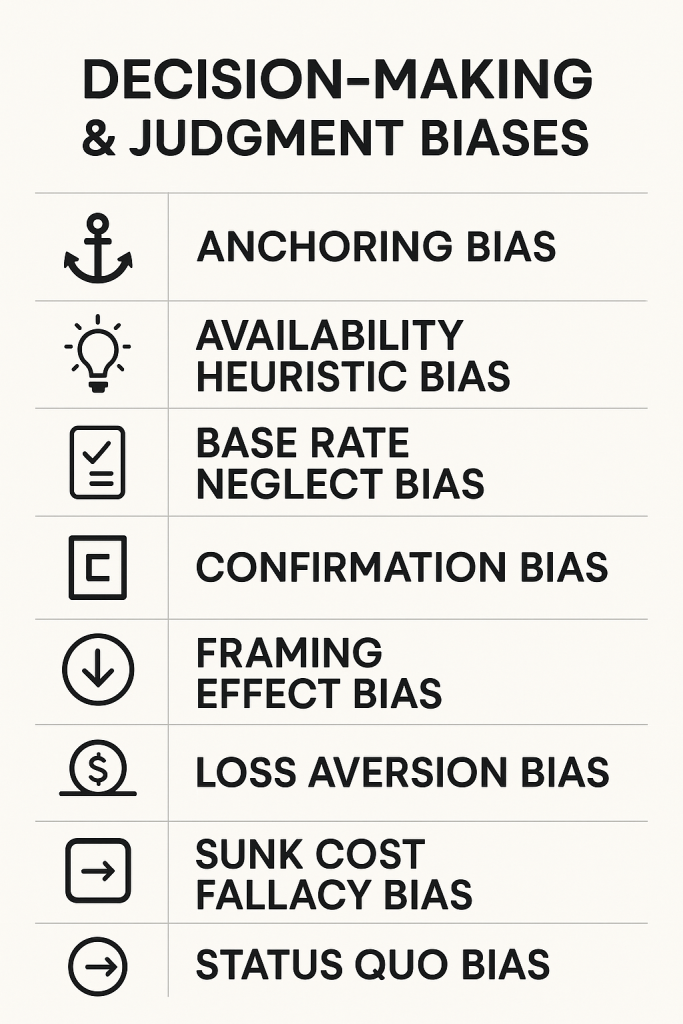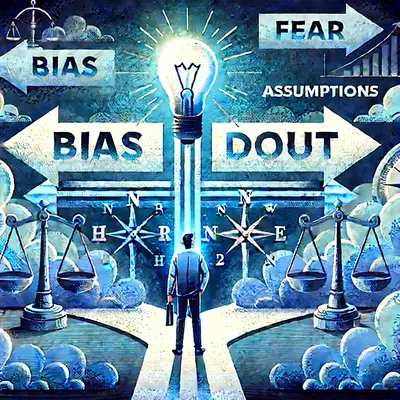Every choice you make, from the small to the life-altering, feels like a deliberate act of will. We tell ourselves a powerful story about our own rationality—that we weigh the evidence, analyze the pros and cons, and then make the most logical decision. But what if that’s just a clever illusion? What if your mind is secretly a battlefield, and your logic is constantly in a tug-of-war with a network of hidden shortcuts you don’t even know exist?
Today we will embark on the fascinating world of cognitive biases. Think of them as the brain’s automatic navigation system- one of the cognitive forces behind every decision you make. These aren’t flaws in your intelligence; they’re the brain’s evolutionary tools for making quick, efficient judgments in a complex world. The problem is, they often lead us to misinterpret information, dismiss crucial facts, and make decisions that go against our best interests.
The landscape of cognitive biases is vast, and a deep dive into each one could take several hours. To keep this article short and sweet, this post will serve as an introduction to cognitive bias, in which we will go into some of the most common cognitive biases in decision-making and judgement.

Anchoring Bias
This occurs when your biases are based on the first piece of data you received about a topic. For example, if a used car salesman says a car is $10,000 then he sells it to your for $8,000, you think you got a $2,000 discount. But you didn’t. He just gave you that $10,000 figure to ‘anchor’ your thoughts, before offering the lower amount to make it sound like a bargain but in actuality he was always going to sell it to you for $8,000.
Availability Heuristic Bias
This occurs when you’re more likely to believe or recall information that is most available to you at the moment in time. For example, imagine you were just cleaning your carpet, then, you go outside and realize your car has a smudge on it. Your first thought might be to get the carpet cleaner because that’s what you were just thinking about! Really, you should be going to the shed to get your car polish. But your brain just went straight to the most recent thing you were thinking about.
Base Rate Neglect Bias
Base rate neglect bias is a cognitive bias that happens when you ignore or undervalue the base, or initial, rate of something in favor of new information. For example, you might hear about several shark attacks on the news and consequently overestimate your risk of a shark attack during your beach vacation, even though the base rate of shark attacks is extremely low. This bias can lead to distorted perceptions of risk and probability.
Confirmation Bias
This occurs when you are likely to believe things that appear to confirm your pre-existing thoughts or opinions on a matter. This prevents you from assessing all new pieces of information in an objective and open-minded manner. For example, sometimes, police are so convinced they have found the perp that they try to make all the new evidence they find fit into their narrative that the suspect is guilty – this has led to many false convictions over time! Another example is in debate and politics when an individual has already aligned with a particular viewpoint, they will likely seek out evidence that already support their concluding viewpoint and may not assess the evidence of opposing viewpoints.
Framing Effect Bias
The framing effect bias is most commonly seen in the media, where media may frame a news item in such a way that they are encouraging viewers to see the issue from a particular perspective. It is also seen in movies, where the filmmaker might frame the story in such a way to make us empathize with one character and loathe another character. Consider these two statements: “The surgery has a 90% survival rate.” vs. “There is a 10% mortality rate associated with this surgery.” Even though these two statements are saying the same thing about survival rate outcomes, as a patient you would likely be more at ease if your doctor told you the first statement as opposed to the second statement.
Loss Aversion Bias
As the name suggests, this bias is when an individual feels pain of loss more strongly than the pleasure of equivalent gain. Consider this scenario: Imagine you are offered a choice between two options:
Option A: A coin is flipped. If it’s heads, you win $100. If it’s tails, you lose $100.
Option B: You do nothing.
If you are like most people, you would choose Option B and not take the gamble.
Why? The potential gain ($100) is equal to the potential loss ($100) in a rational sense. However, the emotional pain of losing $100 is psychologically felt much more intensely than the pleasure of gaining $100. Research suggests that the pain of a loss can be about twice as powerful as the joy of an equivalent gain. Therefore, your aversion to the pain of losing outweighs the potential pleasure of winning, causing you to avoid the gamble altogether. This can help explain why many individuals tend to be more risk adverse.
Sunk Cost Fallacy Bias
Sunk cost fallacy bias occurs when you continue a behavior or endeavor based on the already invested resources, such as time, money or effort, disregarding the potential negative outcomes. For instance, imagine you bought a ticket to a music concert but on the day of the event, you fell ill. Instead of resting, you force yourself to attend the concert because you already paid for the ticket. This is a classic example of the sunk cost fallacy – you’re more focused on the initial cost rather than what would be best for you at the present moment.
Status Quo Bias
Status quo bias occurs when you favor the current state of affairs and resist change, even if the change might be beneficial. For instance, an investor might hold onto a non-performing asset because they’ve been invested into this same asset for 10 years, even though selling it and buying a more promising asset might be the more rational decision. This bias can inhibit growth and progress, as it prevents you from adapting to new circumstances or taking advantage of better opportunities.
So how do we eliminate cognitive biases? unfortunately, we cannot eliminate our cognitive biases as these are innate to human nature but we can develop structures approaches to help mitigate the impacts on our decision making. The most crucial first step is being informed, simply knowing that biases exist and acknowledging that you are susceptible to them is half the battle. You can’t fight an enemy you don’t know you have. Secondly, create systematic processes. Don’t rely solely on intuition, especially for important decisions. Create a systematic process that forces you to be more objective. Lastly, seek diverse perspectives. Our biases thrive in echo chambers. Breaking out of your own perspective is a powerful debiasing technique
If you are curious about learning more about the other cognitive biases share this post and subscribe so you do not miss out.

